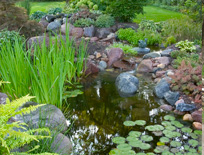Don’t Forget the Shelves!

 Whether you’re installing a small residential watergarden or a large commercial pond, the key to producing one that is both natural-looking and easy to plant is largely determined by how you design the excavation.
Whether you’re installing a small residential watergarden or a large commercial pond, the key to producing one that is both natural-looking and easy to plant is largely determined by how you design the excavation.
That may seem obvious, but building a top-notch pond really does call for planning and excavating in such a way that you can accommodate the needs of a variety of aquatic plants at the various depths they require to thrive. If you wait to think about the plants until after the pond is installed, you’ve missed your chance to get things right.
This doesn’t mean you need to think ahead about individual plants and specific locations. Instead, think in terms of broad shelves that encompass the ideal water depths for the ranges of plants you want to include.
- Marginals, for example, require a water depth from one to 12 inches, depending on the type of plant. In general, however, we recommend setting a shelf at 10 inches to take care of most plants in this category.
- Water lilies thrive in between 12 and 36 inches of water. You can’t go shallower: Even hardy water lilies planted in less than 12 inches of water may not survive over winter.
- Oxygenators (including Anacharis, Hornwort or Cabomba) also prefer being planted in 12 inches to 36 inches of water.
The important point here is that different plants and plant types have different requirements. If you plan your pond knowing what specific plants you want and the specific depths they require, carving out shelves for them is a straightforward proposition.
By altering depths in different areas, you create opportunities for both visual and biological variety within your ponds. And remember, just because you’ve set up a shelf doesn’t mean you need to plant it. The importance of planning — especially excavating with a plan — is that you’re giving yourself flexibility in your ultimate planting decisions.
As you map things out, remember that the width of the shelves is critical to determining how much space you actually have for plants.
I often think of these shelves the same way landscape designers think of foundation plantings around houses: If you come just two feet away from the house with the planting bed, the selection of perennials, annuals and shrubs will be severely restricted as they grow. But take that same planting strip and add some bends and curves that allow the bed to come out a few more feet in certain areas, and you have opened things up to a whole new range of plants — and maybe even a tree.
The same basic principle holds true when you’re designing and planting a watergarden. Unfortunately, most guidebooks on pond construction will demonstrate how it’s done with a kidney- or figure-eight-shaped pond with a strip of shelves that extend about 18 inches inside the edge. While such a design is adequate, it’s also a bit dull. The uniform shelves have a formal look and seem rather unnatural. What’s worse, they don’t allow for proper planting spaces.
Instead, try varying the shelf width, maybe increasing it to three feet along portions of the far side of the pond. This will provide space for a wide variety of plants at the margin and will give you the option of setting up what can seem like a wetland edge.
As you plan, always keep primary viewing locations in mind. Excavating a wide marginal shelf along the far side of the pond will allow you to plant a dense selection of tall aquatic plants and create a natural-looking background. Then put a narrower shelf on the near side and plant it with shorter plants. This will keep the best viewing angles open.
Also, you might consider eliminating a portion of the near-side planting area altogether. Instead, create an edge where the pond meets up with a hardscape or formal viewing area. Providing a deeper section of plant-free water here will allow fish to come to the side of the pond and greet the owner for feeding.
Aquatic plants will go a long way in beautifying a pond and tying it into its surrounding landscape. Your mission is to figure out ways to use them to best effect, and planning with shelves is the key to making it happen!
Brian Helfrich is construction manager for Aquascape, a waterfeature design and installation company in St. Charles, Ill. A nationally recognized instructor on pond installation, his work has been featured in numerous publications, including Better Homes & Gardens and Nature’s Garden. For more information, visit www.aquascapeinc.com.









